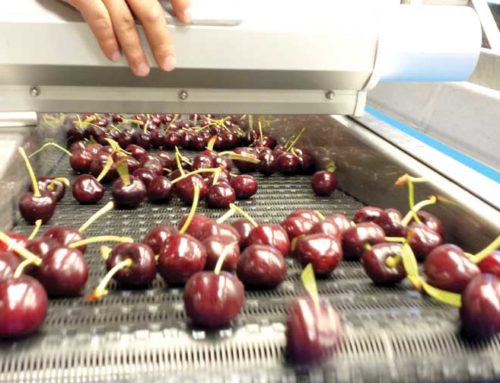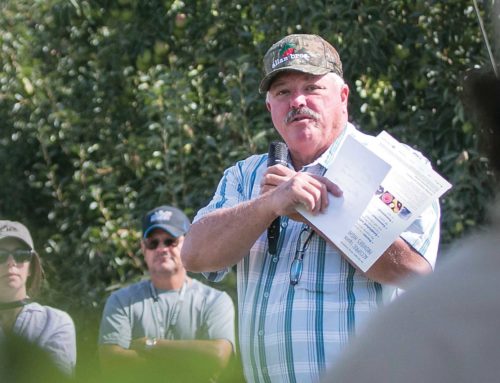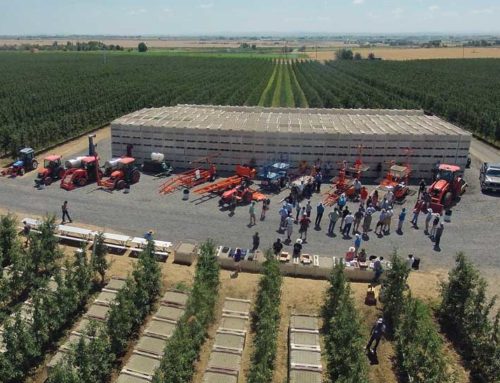
Dave Allan shows the growth difference in trees planted in unfumigated ground (on the left) versus those fumigated with
Telone C-35 on the right.
(Geraldine Warner/Good Fruit Grower)
Figuring out how to get a replanted orchard into early production is the focus of a new planting at Allan Brothers, Inc., near Yakima, Washington. An old Red Delicious orchard was removed in 2002, and the ground was left fallow for a year. Honeycrisp trees were planted in the spring of 2004. The Washington Tree Fruit Research Commission is conducting several research projects in the block. The first compares fumigation treatments.
Some rows in the block were broadcast fumigated with Telone C-35 (1,3-dichloropropene and 35% chloropicrin), some were treated with Vapam (metam sodium) applied by sprinklers, and others were not fumigated. According to Dr. Mark Mazzola, researcher with the USDA in Wenatchee, Washington, Telone is primarily a nematicide, but the chloropicrin in the formulation is a fungicide. Vapam probably controls the same organisms, he said. Production of methyl bromide is due to end this year.
One of the benefits of methyl bromide in annual crops is its herbicidal effect, but that is less important in perennial crops, such as apples, because the effect is not long lived and weeds have to be controlled throughout the life of the orchard. The block includes trees on various Geneva rootstocks from New York, some of which are thought to have some resistance to replant disease. If so, Allan said it would reduce costs if growers could use those rootstocks and not have to fumigate. The control rootstocks are Malling 26, M.9, and Budagovsky 9.
Soil amendments
Another aspect of the project compares soil treatments at the time of planting. For example, 12 to 24 pounds of rotting alfalfa were incorporated into the soil where some trees were planted. Trees planted in the highest rates of alfalfa didn’t grow very well. Some trees were treated with 30 pounds of hop waste, and Allan said there was a definite growth response. The treatment is more expensive than fumigation because of the cost of hauling the waste to the orchard, but it might be an option for organic production.
He’s also wondering if the alfalfa or hop waste could be applied as a postplanting mulch treatment for trees that aren’t growing well, since even after fumigation, some trees don’t thrive as well as others. Allan said trees in the rows fumigated with Vapam have more variable growth than those fumigated with Telone, which could be related to uneven coverage by the sprinklers through which the Vapam was applied.
Tom Auvil, research horticulturist with the Research Commission, said early growth of the trees influences when commercial yields occur, and the trial at Allan Brothers shows the importance of a good, uniform fumigation treatment. Trees in rows treated with Telone, which was shanked in with a tractor, are growing more uniformly, Auvil said. Because Vapam is applied with water, the fumigant goes wherever the water goes, and there can be waves of vigorous trees or less vigorous trees through the orchard. Where Allan used sleeping eyes rather than full-grown nursery trees, there are a lot more places where the trees didn’t grow in the area treated with Vapam than in the Telone-treated part.
—
Poor tree growth is a big problem
In Washington State, there’s not much new land available that’s suitable for tree fruits, so the challenge of pulling out an old orchard and getting the new trees to grow big enough to be productive is one that many growers face, says Dave Allan. “I would say just looking around in this region, maybe 25 percent of the orchards that have been replanted in the last four to five years have acute replant problems,” said Allan, who is in charge of the orchards at Allan Brothers, Inc., a growing and packing company based in Naches, near Yakima. Allan figures that in north central Washington, perhaps 35 percent of replanted orchards have replant problems. “If you never get your trees big enough to get 20 bins per acre, it’s a horrible place to be. They’re not bad enough to pull out, but not big enough to make you money. They get stuck there.” There are many Red Delicious orchards that are only marginally profitable, he noted, and growers fall into the trap of thinking that though they are not generating much money, at least they’re covering overhead. “That basic philosophy will eventually take you to the poor house,” Allan said. “That argument’s used quite a bit. It’s a huge challenge out there to solve the replant problem. That’s why we’re working with the Research Commission on that.”






Leave A Comment